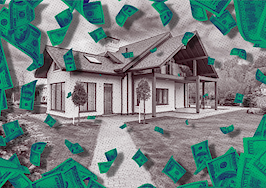The verdict is in — the old way of doing business is over. Join us at Inman Connect New York Jan. 23-25, when together we’ll conquer today’s market challenges and prepare for tomorrow’s opportunities. Defy the market and bet big on your future.
Federal Reserve Chair Jerome Powell seized on a scheduled speaking appearance at Spelman College Friday as an opportunity to deflate rising expectations that the central bank might begin lowering interest rates in the spring, dismissing such talk as premature speculation.
But with more data pouring in that the economy is cooling, bond market investors interpreted Powell’s remarks as “jawboning” — rhetoric intended to keep interest rates from falling too rapidly without the Fed having to actually take action by raising rates.
The Fed “is strongly committed to bringing inflation down to 2 percent over time, and to keeping policy restrictive until we are confident that inflation is on a path to that objective,” Powell said in his prepared remarks at Spelman College. “It would be premature to conclude with confidence that we have achieved a sufficiently restrictive stance, or to speculate on when policy might ease.”
Powell said Fed policymakers are prepared to raise interest rates further if needed to fight inflation but are “making decisions meeting by meeting, based on the totality of the incoming data and their implications for the outlook for economic activity and inflation, as well as the balance of risks.”
Bond market investors who fund most mortgages remain convinced that the Federal Reserve is getting inflation under control and is not only done with rate hikes but will begin lowering rates in the spring to avoid strangling the economy.
The CME FedWatch Tool, which tracks futures markets to predict the odds of the Fed’s next moves, showed investors on Friday saw a 63 percent chance of one or more Fed rate cuts by March 20, up from 43 percent the day before and 21 percent on Nov. 24.
10-year Treasury yields keep falling

Source: Yahoo Finance.
Yields on 10-year Treasury notes, which often predict where mortgage rates are headed next, continued to trend down dramatically Friday after Powell’s speech, falling 13 basis points to 4.23 percent. Mortgage News Daily’s lender survey showed rates on 30-year fixed-rate loans falling 6 basis points Friday, to 7.09 percent.
With today’s drop, yields on 10-year Treasurys are down more than three-quarters of a percentage point from a 2023 high of 5 percent registered Oct. 22, the highest level since 2007.
Interest rates have been falling for more than a month as report after report comes in showing that the economy is slowing rapidly, and could be headed for a recession.
Mortgage rates registered their biggest one-day drop in nearly four years on Nov. 14 after the Bureau of Labor Statistics reported that the all-items Consumer Price Index (CPI) fell to 3.2 percent in October, down from 3.7 percent in September.
The Fed’s inflation gauge: Core PCE
On Wednesday, the Commerce Department reported that the core personal consumption expenditures (PCE) price index, a crucial benchmark that excludes food and energy prices and which Fed policymakers want to see at 2 percent, fell to 3.5 percent in October, down from 3.7 percent in September and 4.7 percent in May.
“Overall core PCE rose at only a 2.2 percent pace in the three months to October, compared to the previous three months, so the short-term rate of price increases is now very close to the target, and slowing,” economists at Pantheon Macroeconomics said in their Dec. 1 U.S. Economic Monitor to clients. “But Chair Powell and his colleagues can’t afford to be wrong about upside inflation risks twice in the same cycle, so they need more convincing than previous Feds that inflation is back.”
More evidence that the economy is slowing came Thursday in the form of a Department of Labor report showing ongoing unemployment claims hit 1.927 million during the week ending Nov. 18, the highest level since November 2021.
On Friday, the Institute for Supply Management (ISM) reported that economic activity in the manufacturing sector contracted in November for the 13th consecutive month.
The ISM’s Manufacturing PMI was unchanged at 46.7 percent, undercutting expectations of economists polled by Reuters who had expected it to come in at 47.6 percent. A Manufacturing PMI reading below 50 percent indicates manufacturing is declining. A reading below 48.7 percent, over a period of time, indicates that the overall economy (gross domestic product) is generally declining.
Bond market investors also took heart this week from remarks Federal Reserve Governor Christopher Waller made at an event hosted by the American Enterprise Institute. An inflation hawk, Waller said he sees signs that inflation is easing and that the Fed would be open to cutting rates if the trend continues.
Forecasters at Pantheon Economics say that while spikes in core services prices in July and September “appear to be isolated events,” Fed policymakers will want those events “to be firmly in the rear-view mirror before they signal definitively that they are done hiking, never mind easing.”
“We expect Chair Powell to remain cautiously optimistic at his press conference on Dec. 13, but no more than that,” Pantheon economists said of the Fed’s next scheduled meeting.
“When the Fed flip comes, however, we expect it to be quick,” Pantheon forecasters said. “The combination of modest sequential price increases, slower economic growth, and a gradual uptrend in unemployment, will make it clear that maintaining nominal rates at their current level will just amplify the pressure on an economy which doesn’t need to be squeezed hard in order to return inflation to the target.”
Powell’s Spelman College remarks
In a question and answer session with Spelman College President Helene Gayle and students at the historically black college for women in Atlanta, Powell stuck to his mantra that the Fed continues to see inflation as a threat — and that incoming data will determine whether to raise rates, leave them where they are, or bring them down.
“Policy is at a restrictive level, meaning it’s holding the economy back,” Powell said. “Inflation is still running well above target, but it’s moving in the right direction. So we think the right thing to be doing now is to be moving carefully.”
After implementing 11 rate increases since March 2022 that brought the short-term federal funds rate to a 22-year high of 5.25 percent to 5.5 percent, Fed policymakers haven’t raised rates since July.
“Let the data reveal the appropriate path,” he said. “We don’t need to be in a rush now, having moved quickly and forcefully [to raise rates], we’re getting what we wanted to get. We now have the ability to move carefully.”
Long-term rates kept climbing after Fed pause
While the Fed has direct control over short-term interest rates, long-term rates on government bonds and mortgage-backed securities depend on supply and investor demand.
Long-term rates continued to trend up for nearly three months after the Fed was done hiking short-term rates, in part because bond market investors demanded larger term premiums to compensate them for the losses they could face if rates reverse.
The recent dramatic drop in long-term rates could in itself represent easing that allows the Fed to simply leave short-term rates where they are — the “higher for longer” strategy — if the economy looks to be headed for a so-called soft landing rather than a recession.
In their Dec. 1 U.S. Economic Monitor, forecasters at Pantheon Macroeconomics said they’re sticking to their view that the Fed will lower short-term rates by 1.5 percentage points next year, “starting in March. The sooner, the better.”
Forecasters at Fannie Mae and the Mortgage Bankers Association agree that the U.S. is probably headed for a mild recession next year, although they differ on how much that would bring mortgage rates down.
Mortgage rate forecasts diverge

Source: Fannie Mae and MBA forecasts, November 2023.
In their Nov. 21 forecast, economists at Fannie Mae see the Fed pursuing a higher for longer rate strategy, which would keep mortgage rates above 7 percent next year.
But forecasters at the Mortgage Bankers Association projected in a Nov. 17 forecast that mortgage rates will fall to the mid-6 percent range by the end of next year and drop into the mid-fives by the end of 2025.
Get Inman’s Mortgage Brief Newsletter delivered right to your inbox. A weekly roundup of all the biggest news in the world of mortgages and closings delivered every Wednesday. Click here to subscribe.












